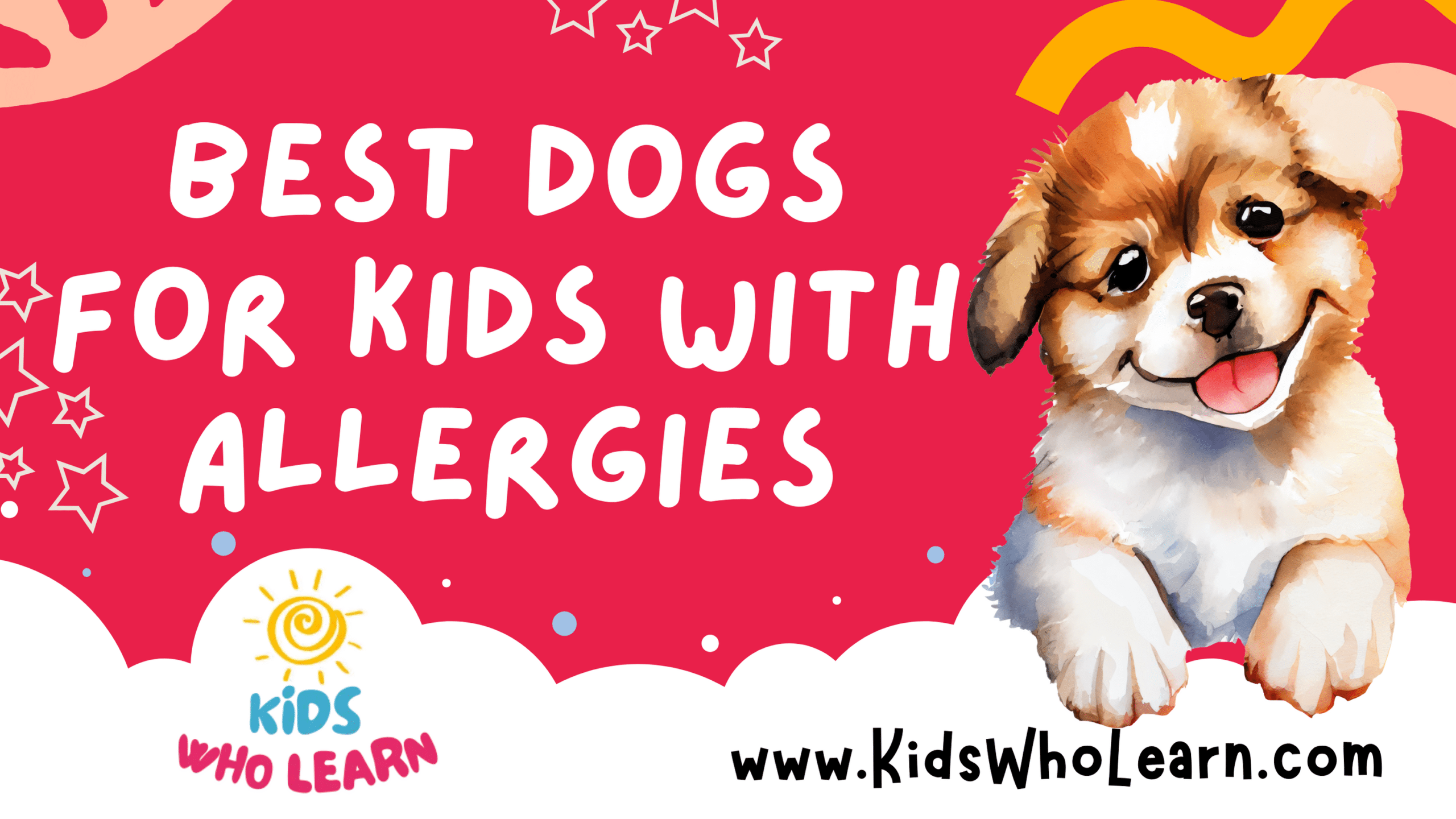Allergic reactions can be a significant barrier for families hoping to add a four-legged member to their pack, especially when children are involved. However, the concept of ‘hypoallergenic dogs’ presents a glimmer of hope, offering the potential for a pet that won’t trigger sniffles and sneezes. While no dog breed is completely allergen-free, certain breeds are known to produce fewer allergens than others, making them a more suitable option for households with allergy sufferers.
When considering a family dog for a home with allergic kids, it’s important to understand what makes a dog hypoallergenic. These breeds typically have hair that is more similar to human hair, produce less dander, or have a non-shedding coat that reduces the spread of allergens. Factors like the size of the dog, grooming requirements, and the dog’s individual temperament should also be taken into account when making a selection. The goal is to find a breed that fits the family’s lifestyle, while also keeping allergic reactions to a minimum.
Key Takeaways
- Certain breeds deemed hypoallergenic may be suitable for families with allergies.
- Hypoallergenic dogs have qualities like non-shedding coats that reduce allergen spread.
- Choosing the right dog requires considering size, grooming needs, and temperament.
Understanding Canine Allergies
We need to consider that despite the joy dogs bring to families, they can also be a source of allergies, particularly in children. Certain proteins found in a dog’s dander, saliva, and urine can be potent allergens. Let us explore the key aspects of dog allergies.
The Basics of Dog Allergies
Dog allergies are typically a reaction to specific proteins found in a pet’s skin cells, saliva, or urine. These allergies manifest when our immune system responds to these otherwise harmless proteins as if they were dangerous pathogens. Dander, or flakes of dead skin, along with fur that dogs shed, can carry these proteins. This exposure can lead to symptoms such as sneezing, itchy eyes, and respiratory issues in sensitive individuals.
Common Allergens in Dogs
The main allergens in dogs are proteins present in:
- Dander: The dead skin cells dogs shed.
- Saliva: Proteins that become airborne when the dog licks itself.
- Urine: Can spread allergens when it dries and particles become airborne.
Even non-shedding dogs produce these proteins, although they may spread less dander and hair into the environment.
Allergy-Free vs. Hypoallergenic
No dog breed is entirely allergy-free, but hypoallergenic breeds generally produce fewer allergens than others. It’s a common misconception that fur is the trigger for allergies. In reality, it’s the proteins in the dog’s dander, saliva, and urine that cause allergic reactions. Although hypoallergenic dogs have non-shedding coats which lower the spread of allergens, complete elimination of allergens is not possible.
Managing Allergies with Proper Grooming
Proper grooming can significantly reduce the presence of allergens. Strategies include:
- Regular baths: Helps reduce the amount of dander and loose hair.
- Brushing: Preferably done outdoors to minimize the spread of allergens indoors.
- Clean surroundings: Regular cleaning of the dog’s bedding and the home environment to remove accumulated dander and fur.
For many allergy sufferers, these measures, combined with medical treatment options like immunotherapy or antihistamines, allow them to cohabitate with dogs more comfortably. Pollen can also adhere to a dog’s fur, contributing to allergy symptoms, hence regular cleaning might also reduce these environmental allergens.
Characteristics of Hypoallergenic Dogs
We understand that finding a suitable dog for families with allergies is paramount. Our focus here is on the specific characteristics of hypoallergenic dogs that make them the right fit for such households.
Non-Shedding Coat Types
Non-shedding coat types are essential characteristics of hypoallergenic dogs. These coats produce fewer allergens as they retain more dander, which is a common allergen. Examples of non-shedding coats include:
- Single Coat: Dogs with a single layer of hair, such as Poodles, generally shed less.
- Curly or Wavy Coat: Breeds like Bichon Frises with curly hair are more likely to hold dander and shed less.
Fur vs. Hair in Dogs
Understanding the difference between fur and hair can guide us in choosing a hypoallergenic dog. Hair tends to grow longer and has a slower growth cycle, resulting in less shedding compared to fur. Dogs with hair-like coats are:
- Maltese
- Yorkshire Terrier
Shedding and Dander Control
Shedding and dander control is a pivotal consideration for reducing allergic reactions. Here are practical ways we can achieve this:
- Regular Grooming: Brushing and bathing a dog regularly can significantly reduce the amount of dander.
- HEPA Filters: Using HEPA air purifiers helps remove dander from the air.
Selecting the Right Hypoallergenic Dog for Kids
When choosing a hypoallergenic dog for kids, it’s essential to consider temperament, energy needs, and size. These factors ensure a good match for a child’s lifestyle and a family’s living situation.
Assessing Dog Temperament
We prioritize the importance of a dog’s temperament. A loyal and gentle dog can be a fantastic addition to any family. Look for breeds known for their affable nature; Poodles, both miniature and standard, are renowned for their smart and friendly temperament. The Bichon Frise, too, is celebrated for its affectionate and easygoing disposition.
- Loyal: Soft Coated Wheaten Terrier, Labradoodle
- Gentle: Shih Tzu, Italian Greyhound
Energy Levels and Exercise Needs
Understanding a dog’s energy levels and exercise needs is crucial. Kids with lots of energy may do well with a playful and energetic breed that will enjoy frequent playtimes and walks. For instance, Schnauzers are known to be spirited and need regular exercise to stay happy. Conversely, if you have less time for daily exercise, consider a less active breed.
- Playful, High Energy: Miniature Schnauzer, Yorkshire Terrier
- Moderate Exercise: Maltese, Havanese
Size Considerations for Family Pets
Lastly, we contemplate size because it impacts the living space and a child’s ability to interact safely with the pet. Small dog breeds can be more suitable for families living in apartments, as they require less space and are easier to manage. The Cavachon is a small-sized breed known to be family-friendly. Nevertheless, regardless of size, training and proper introductions are vital to foster a safe and positive relationship between the dog and children.
- Small Dog Breeds: Cavachon, Coton de Tulear
- Family-Friendly: Miniature Poodle, Brussels Griffon
Top Breeds for Children with Allergies
When selecting a dog for a household with allergies, we focus on breeds known for their hypoallergenic qualities, which can greatly reduce the incidence of allergic reactions.
Bichon Frise and Its Qualities
The Bichon Frise is renowned for its fluffy, hypoallergenic coat that doesn’t shed much, making it an excellent companion for children with allergies. They embody a loving demeanor, which makes them a joy around kids.
The Poodle Family
Poodles come in three sizes: standard, miniature, and toy, all of which sport a unique, hypoallergenic curly coat. Their intelligence and ease of training make them suitable for families and gentle with children. The Barbet and Irish Water Spaniel, related to Poodles, also offer low-shedding coats suitable for allergic homes.
Distinctive Features of the Schnauzer
The Schnauzer, available in standard, miniature, and giant sizes, possesses a distinctive double coat that minimizes loose dander. These dogs are vigorous and attentive, yet also form strong, loving bonds with family members.
Soft Coated Wheaten Terrier and Family Life
Soft Coated Wheaten Terriers are friendly, exuberant dogs with a single silky coat that is less likely to trigger allergies. Their playful and affectionate nature makes them a natural fit for a lively household.
The Unique Hairless Breeds
Hairless breeds such as the Chinese Crested, Xoloitzcuintli, and the American Hairless Terrier offer an alternative for allergy sufferers, as lack of hair means fewer allergens in the home. Despite their lack of coat, regular skin care is necessary.
Exploring Other Hypoallergenic Breeds
Other breeds worth considering include the Coton de Tulear with its cotton-like coat, the corded curls of the Komondor, and low-shedding Lagotto Romagnolo. All present hypoallergenic traits and adapt well to family life. The Bedlington Terrier and Kerry Blue Terrier also have woolly coats that trap dander, while the Spanish Water Dog and Portuguese Water Dog round out the water-loving hypoallergenic options.
Living with a Hypoallergenic Dog
When considering a family dog for homes with allergy sufferers, choosing a hypoallergenic breed is only the first step. We must also create an environment that minimizes allergens and establish regular care routines to keep allergy symptoms at bay.
Home Environment Adjustments
Air Filtration: We recommend investing in high-efficiency particulate air (HEPA) filters to regularly purify the air and capture pet dander. Placing HEPA filters in key living areas can significantly reduce airborne allergens.
Allergen Barriers: Utilize cheesecloth to cover vents, as this can help trap larger particles before they circulate through the home. Also, choose easy-to-clean furniture and flooring that won’t trap dander.
Tips for Reducing Allergy Symptoms
- Designate Allergy-Free Zones: Maintain certain areas, like bedrooms, as dog-free to give allergy sufferers a place to recover from exposure.
- Clean Regularly: Use a vacuum with a HEPA filter and damp mop floors frequently to reduce the presence of allergens.
- Personal Hygiene: After interacting with the dog, we should wash our hands and change clothes if necessary to minimize spreading allergens.
Regular Dog Care Commitments
Grooming: Routine grooming is essential; we should brush the dog regularly, ideally outside, to prevent loose hair and dander from accumulating indoors.
Bathing: While over-bathing can irritate the dog’s skin, striking a balance is crucial. Bathing our dog once a week can help control dander.
Professional Help: Consider professional grooming services if time is scarce. These services often have the necessary tools and expertise to reduce allergens effectively.
By following these guidelines, we can create a healthier environment for our family and enjoy the companionship of a hypoallergenic dog with fewer allergy concerns.
Health and Safety Considerations
When it comes to choosing the best dogs for kids with allergies, we must take health and safety into account to ensure a conducive environment for the child and the pet. Our focus lies on regular health check-ups, recognizing breeding issues that may impact allergies, and the comparative significance of dog allergies in the household setting.
Routine Health Checks
We understand the importance of regular veterinary check-ups to maintain the health of any dog breed, especially those that are hypoallergenic. For instance, breeds like the Labradors and Saint Bernards, while not the most suitable for allergy sufferers, can still be part of a household with meticulous grooming routines that reduce the spread of allergens.
- Vet Visits:
- Frequency: At least once a year
- Focus Areas: Skin and coat health, which affect allergen levels
- Grooming Needs:
- Labrador Retriever: Moderate; requires regular brushing
- Saint Bernard: High; needs frequent grooming to manage shedding
Understanding Potential Breeding Issues
We prioritize knowledge of a dog’s lineage and breeding to discern any inherited health conditions that can influence allergies. Breeding practices play a critical role in managing population-specific issues such as overbreeding and genetic health problems which can exacerbate allergy concerns.
- Breeding Considerations:
- Inherited Disorders: Be aware of disorders like atopic dermatitis
- Population Health: Promote responsible breeding to reduce exacerbation of common breed-related allergies
Allergies to Dogs vs. Other Pets
We recognize that individuals with allergies respond differently to various pets. Dog allergies are often caused by proteins found in the animal’s skin cells, urine, and saliva. While there is no completely hypoallergenic dog breed, some breeds are generally better for those with allergies.
- Comparative Allergy Triggers:
- Dogs: Dander is the primary allergen
- Other Pets: Saliva, urine or even feathers might be problematic
- Household Management: Regular cleaning reduces allergen presence
- Dog Selection:
- Aim for breeds with less shedding and dander production
- Consider breeds known for being hypoallergenic, such as Poodles or Schnauzers, rather than Labrador Retrievers or Saint Bernards
Expert Advice and Resources
When considering a dog for a family with allergies, it’s crucial to consult with experts and utilize reputable resources to make an informed decision. We’ll explore some of the best ways to ensure a safe and happy integration of a hypoallergenic dog into your home.
Consulting with Allergists
Allergists are medical doctors (MDs) specializing in the diagnosis and treatment of allergies. Before adopting a dog, we recommend visiting an allergist, who can provide specific tests to determine which breeds may be less likely to trigger allergy symptoms. The Asthma and Allergy Foundation of America (AAFA) is a valuable resource for finding a qualified allergist and learning about pet allergies, which can be caused by dander, saliva, and urine, not just pollen.
Selecting a Dog Breed with the AKC
Selecting a suitable dog breed is paramount. The American Kennel Club (AKC) offers comprehensive details on dog breeds, including those that are considered hypoallergenic. While no dog is 100% allergen-free, some breeds shed less dander and hair, which can reduce the risk of allergy symptoms. On the AKC website, you can find:
- A list of hypoallergenic breeds
- Descriptions of each breed’s temperament and care requirements
- Information on breed-specific clubs
Educational Materials for Families
It’s essential for families to educate themselves about living with allergies and pets. We encourage the use of educational materials such as:
- Books and brochures that explain allergies and hypoallergenic pets in child-friendly language.
- Online courses and webinars provided by allergy awareness organizations to help families manage allergies.
- Guides on pet care and the allergen-reducing grooming routines necessary for hypoallergenic breeds.
Utilize these resources and expert consultations to enhance your family’s experience with your new dog while managing allergies effectively.
Conclusion
When we look for the best dog breeds for families with allergy concerns, we focus on those that are considered hypoallergenic. This term indicates breeds less likely to trigger allergic reactions. While no dog is 100% hypoallergenic, breeds like the Poodle, Bichon Frise, and Schnauzer offer families a chance to enjoy a pet with less worry about allergies.
We must underline that regular grooming and cleaning can further mitigate allergens. These practices are essential for maintaining a healthy environment for families with sensitivities.
| Best Breeds | Qualities |
|---|---|
| Poodle | Intelligent, Loyal |
| Bichon Frise | Affectionate, Playful |
| Schnauzer | Alert, Friendly |
| Maltese | Gentle, Loving |
| Shih Tzu | Friendly, Inquisitive |
Each of these breeds has been recognized by the American Kennel Club for their qualities that make them excellent family dogs. Not only do they bring a lower risk of allergies, but they also possess loving and loyal characteristics that solidify their roles as part of a family.
We encourage families to consider individual dog temperament and to spend time with different breeds before making a decision. Our experience has reinforced that the most rewarding matches come from careful consideration of the family’s lifestyle and the pet’s needs. This thoughtful approach ensures a harmonious relationship between a family and their new dog.
Remember, we always recommend consulting with a professional to find the perfect four-legged companion for your household. This way, we ensure that the love and joy a dog brings into a home are shared with comfort and health at the forefront.
Frequently Asked Questions
When searching for the best dogs for kids with allergies, it’s crucial to consider breeds that are hypoallergenic and gentle by nature. Here are some specific answers to common queries to guide you in making an informed choice.
What are the most suitable hypoallergenic dog breeds for children?
In our experience, dog breeds such as the Poodle, Bichon Frise, and Shih Tzu are among the most suitable for children with allergies. These breeds typically have hair that is more similar to human hair, which tends to produce fewer allergens.
Which large dog breeds are considered hypoallergenic and suitable for families with allergy concerns?
Large dog breeds considered hypoallergenic include the Standard Poodle, Portuguese Water Dog, and Afghan Hound. Families with allergies often find these breeds compatible with their needs as they shed less and, therefore, release fewer allergens into the home.
What options are available for medium-sized dogs that have a low shedding coat?
For medium-sized dogs, we often suggest the Schnauzer or the Labradoodle. These dogs have coats that shed minimally compared to other breeds, helping to reduce the potential for allergic reactions.
Are there specific breeds recommended for families with children suffering from allergies and asthma?
Yes, breeds like the Maltese, Poodle, and Soft Coated Wheaten Terrier are known for their compatibility with allergy and asthma sufferers due to their non-shedding coats, which are less likely to trigger symptoms.
How does one choose the best hypoallergenic dog food for their pet with allergy needs?
Identifying the best hypoallergenic dog food involves consulting with a veterinarian to pinpoint your dog’s specific allergies and then selecting a diet formulated to avoid triggering those. It often includes limited ingredients or hydrolyzed proteins to minimize allergenic effects.
Is it possible to adopt a hypoallergenic dog that is good with children?
Yes, adopting a hypoallergenic dog suitable for families with children is possible through breed-specific rescues or shelters that understand the importance of matching hypoallergenic dogs with families coping with allergies.











